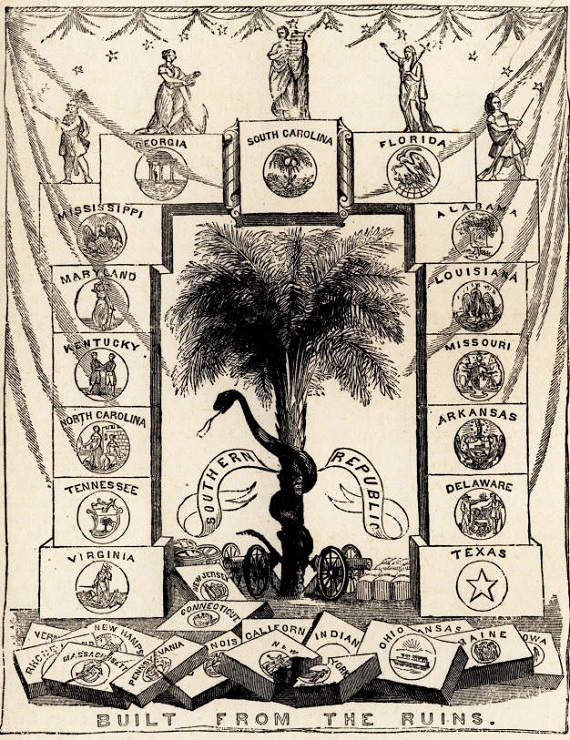Many of us in the South have maintained our faith in the Constitutional right of nullification and secession despite the efforts of massed, bloody, Yankee bayonets. But is the talk about nullification and secession an earnest effort to put forward solutions to an out of control, Deep State, supreme federal government or is it merely an exercise in heady political calisthenics?
I belong to the tribe that believes nullification and secession are the only real solutions to the current out of control supreme federal government. To demonstrate the validity of my belief, I will pose and answer three fundamental questions: (1) Are the concepts of state nullification and secession legitimate American political principles? (2) Is the current supreme federal government a legitimate governing authority? and (3) Would the modern-day acceptance of state nullification and secession be so unworkable that it would destroy the United States?
Lincoln answered the first question—whether state secession is a constitutional right—with a firm negative and enforced his opinion with legions of bloody bayonets. But Lincoln (1861) was not one of America’s (1776) founding fathers; therefore, his opinion pales to insignificance when compared to the actual words of the founding fathers. Even the High Federalist Alexander Hamilton was forced to admit that the Sovereign States had the right to protect their citizens from an abusive federal government:
It may be safety received as an axiom in our political system, that the State government…afford security…against the national authority. [1]
He based this upon the principle of State Sovereignty noting, “The State governments, by their original constitutions, are invested with complete sovereignty.” [2] James Madison expressed his agreement with the principle of State Sovereignty when he wrote:
Do they [the anti-Federalists] require that, in the establishment of the Constitution, the States should be regarded as distinct and independent sovereigns? They are so regarded by the Constitution proposed. [3]
These words from Federalist founding fathers stand in sharp contrast to Lincoln’s opinion. But the anti-Federalists speaking in the State ratification conventions were even more direct. Anti-Federalists in states such as Virginia, New York, and Rhode Island placed wording in their ratification resolutions declaring for all the world to see that the Sovereign State had the right to withdraw its consent to the Union formed by the Constitution should said Union become abusive or encroach upon the rights reserved to the Sovereign States.[4] Nullification and secession are based upon the American principle of State Sovereignty. As a Sovereign, the State may take whatever action it deems necessary to protect its rights and the liberty of its citizens. This includes the right to withdraw powers previously delegated by the Sovereign State to its agent—the federal government. Therefore, according to the founding fathers, nullification and secession are legitimate powers reserved to the Sovereign States. The founding fathers, who believed in liberty, were right—Lincoln, who believed in an all-powerful federal government, was wrong!
By answering the first question, we have raised a much more troubling second question: Is the current supreme federal government legitimate? What was the metric used by America’s founding fathers to determine if a government is legitimate? The metric is clearly stated in the second paragraph of the Declaration of Independence:
Governments are instituted among Men, deriving their just powers from the consent of the governed. That whenever any Form of Government becomes destructive of these ends, it is the Right of the People to alter or to abolish it, and to institute new Government…..
In 1893, agents of the federal government worked to overthrow the Kingdom of Hawaii, and eventually, the United States invaded and deposed the legitimate government of Hawaii—a government with which, up to that time, the United States had diplomatic relations. The United States forced the people of Hawaii to accept a new constitution—one that was not based upon the free and unfettered consent of the people of Hawaii. The native people of Hawaii referred to the new constitution as a “bayonet constitution.”[5] According to the principle of consent as declared in the Declaration of Independence, the subsequent governments of Hawaii are illegitimate—because they are based not upon consent but upon coercion. If this is true for Hawaii of 1893, then it must also be true for the South of 1865.
As demonstrated in answering the first question—in America’s original Republic, ultimate authority for government resides with the Sovereign States. The federal government was a creature of the States and served as its agent in certain and specific areas. But post-Lincoln, the federal government became the ultimate judge as to the extent of its own powers. This radical power shift occurred as a result of the imposition of bayonet constitutions in the states of the former Confederacy and the imposition, by bayonet, of Reconstruction Acts and the Fourteenth Amendment.[6] The supreme federal government substituted military coercion for the free and unfettered consent of “we the people” of the South; therefore, all subsequent governments are illegitimate according to the American metric of legitimate governments as stated in the Declaration of Independence.
While the founding fathers and the ratifying conventions of Sovereign States specifically designed and endorsed a constitutionally limited federal government with the States as co-equal branches, it is clear today that we are living under the iron-rule of a supreme federal government capable of forcing its subjects to “hear and obey.” Professor Edward S. Corwin, writing in 1941, noted that there were no longer any limits to the powers of the federal government. He approvingly observed, “the National Government is entitled to employ any and all of its powers to forward any and all of the objectives of good government.” [7] And of course, the elites who control the federal government get to decide what is and what is not “good government.” Today, there is no doubt as to where supreme governmental power resides—it resides with the elites who control the federal government. All nine Federal Supreme Court Justices in Cooper v. Aaron, 358 U.S. 1 (1958), “…declared the basic principle that the federal judiciary is supreme in the exposition of the law of the Constitution.” [8] In Baker v. Carr, 369 U.S. 186 (1962) the Federal Supreme Court instructed state legislatures regarding the apportionment of the legislatures of the once sovereign states—clearly demonstrating that “states” had become mere provinces of Lincoln’s newly and unconstitutionally created Federal Empire. If we are courageous enough to measure the current supreme federal government by the American political metric of consent, then we are forced to admit that the federal government has been weighted in the balance and found wanting! It is an illegitimate governing power.
What then can “we the people” do to reclaim America’s original, constitutionally limited Republic of Sovereign States? This question can be answered with two words: “nullification” and “secession.” A constitutional amendment recognizing [9] the Sovereign State’s right of nullification and secession would immediately restore the Republic of Sovereign States as designed by America’s founding fathers.[10] Enemies of State Sovereignty or real States’ Rights immediately claim that an acknowledgment of States’ Rights of nullification and secession would violate Article VI, Section 2 of the Constitution—the so-called “supremacy clause” which reads:
This Constitution, and the Laws of the United States which shall be made in Pursuance thereof; and all Treaties made, or which shall be made, under the Authority of the United States, shall be the supreme Law of the Land.[11]
Calhoun noted that the claim of “supremacy” was predicated upon the law being made “in Pursuance” of the Constitution.[12] This agrees with the writings of Federalist Hamilton:
But it will not follow from this doctrine that acts of the larger society [Federal] which are not pursuant to its constitutional powers, but which are invasions of the residuary authorities of the smaller societies [States], will become the supreme law of the land. These will be merely acts of usurpation and will deserve to be treated as such.[13]
It will not, I presume, have escaped observation, that it expressly confines this supremacy to laws made pursuant to the Constitution.[14]
There is no position which depends on clearer principles than that every act of a delegated authority, contrary to the tenor of the commission under which it is exercised, is void. No legislative act, therefore, contrary to the Constitution can be valid.[15]
The operative words in the Supremacy Clause are “in pursuance” to the Constitution, not “supreme law of the land,” the latter being merely the effect of the former. Federal supremacists claim that the sole power authorized to judge the extent of the federal government’s power is the federal government itself! Such logic belongs to indivisible empires, not to a Republic of Sovereign States.
Not willing to admit defeat, supporters of a supreme federal government then declare that to allow states to exercise sovereign authority (by being the final judge as to whether acts of the federal government are in pursuance of the Constitution) would create a governmental nightmare in which errant states would go rogue by reinstituting Jim Crow laws and even reinstituting slavery! Such claims have been addressed in other places,[16] but to illustrate, let us consider what action the federal government could take if, after the passage of the Sovereign State Amendment, a fictional rogue state—we will call it Oklarado—decided to reduce the cost of providing universal health insurance by euthanizing people after they reach the age of 65. Such state action would be reprehensible. Suppose the Federal Supreme Court declares the state law unconstitutional, but the state of Oklarado nullified the Court’s decision. Would “we the people” of the other Sovereign States be powerless? No! The outraged States could propose a constitutional amendment declaring that no state in this Union will practice euthanasia. If the anti-euthanasia Constitutional amendment was ratified by the States, Oklarado must now decide if the mutual benefit of Union is more valuable than maintaining its euthanasia law. Oklarado’s failure to comply with the new Constitutional Amendment prohibiting euthanasia in the United States would be grounds for its immediate ejection from the Union.[17] If the rogue state is removed from the Union, then the United States could cut off all relations with it. The cost of dis-Union would, in most cases, be too great. But it would require a constitutional majority of the States (3/4s) to pass the Constitutional Amendment that results in the removal of a State. As Chancellor James Kent pointed out, the continuation of the Union depends upon mutual respect between the people within the union.[18] Local self-government is the rule in a Republic of Sovereign States, but each State’s internal policies must be conducted in a manner that will be morally acceptable to the constitutional majority of Sovereign States or else leave the Union.
The current supreme federal government has no real check on its powers. As pointed out by John C. Calhoun, the Constitution is not self-enforcing! [19] The threat of state nullification or secession would be a significant factor causing the federal government to construe the limits of its powers carefully. For example; Obamacare never would have been considered, much less passed, if the once sovereign states had the power of nullification and secession. Nullification and secession are the only real or ultimate checks against an aggressive federal government—a government that is today controlled by power-hungry elites in Washington, D.C. and Wall Street.
[1] The Federalist, No. 28, Great Books of the Western World, Robert M. Hutchins, ed. (The University of Chicago: 1952), 98.
[2] Ibid, The Federalist, No. 31, 105.
[3] Ibid, The Federalist, No. 40, 149.
[4] Calhoun, John C., On the Constitution, in The Works of John C. Calhoun, Vol I. (Appleton & Co., New York, 1851), 248-9.
[5] Kennedy, Walter D., The Confederate State of Hawaii, Confederate Veteran, Jan/Feb 2018, 19.
[6] Kennedy & Kennedy, The South Was Right! (Pelican Publishing, Gretna, LA: 1994), 167-76, 369-74, 375-6, 377-9.
[7] Corwin as cited in Quirk & Bridwell, Judicial Dictatorship (Transaction Publishers, New Brunswick, NJ: 1995), 41.
[8] O’Brien, David M., Constitutional Law and Politics, Vol. 2, (W.W. Norton & Co., New York: 1995), 35.
[9] Recognizing or acknowledging rights belonging to Sovereign States vs the federal government granting these rights.
[10] See The Sovereign State Amendment in Kennedy & Kennedy, Why Not Freedom! (Pelican Publishing Co., Gretna, LA: 1995), 289-97; Kennedy, James Ronald, Reclaiming Liberty (Pelican Publishing Co., Gretna, LA: 2005), 76-9; or Kennedy, James Ronald, Nullification! Why and How, 93-6, free pdf at http://www.kennedytwins.com/Nullification_Book_2012.pdf
[11] Article VI, Section 2, U.S. Constitution.
[12] Calhoun, On the Constitution, 252-3.
[13] The Federalist, No. 33, Great Books of the Western World, Robert M. Hutchins, ed. (The University of Chicago: 1952), 108.
[14] Federalist Papers, No.33, 109.
[15] Federalist Papers, No.78, 231.
[16] Kennedy, James Ronald, Reclaiming Liberty, 75, 191-2.
[17] Removal could be accomplished by an act of Congress signed by the President declaring the rogue state is no longer a state within the United States. Readmission, if desired, would follow the same procedure as the admission of any new state.
[18] Kent, James, Commentaries On American Law (1826, Da Capo Press, New York: 1971), 369.
[19] Calhoun, On the Constitution, 234.







